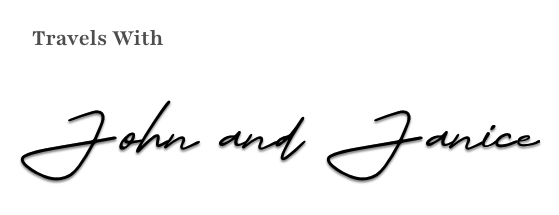The Confederation Bridge
We crossed the bridge and arrived at the info center on the PEI side where we were given great information on the sites to see and places to stay. Since it was mid afternoon, we decided to find a camp site for a few days and use it as a center to travel and see Prince Edward Island. On the north central Green Gables Shore we found Crystal Beach Campground in New Annan. It was a great central point for the next few days.
In the morning we drove into Summerside the largest city on the Western end of PEI, known as the North Cape, to start the tour of the coast, lighthouses and towns. One of the “must” stops is The Bottle Houses. This is almost a post on its own. Over 25 000 recycled bottles were ingeniously cemented together to create the Bottle Houses. They were built by the late Édouard T. Arsenault. He gave birth to these houses after having received a postcard of a glass castle from his daughter in 1979, an attraction she had visited on Vancouver Island in British Columbia. That same summer, he started collecting bottles from his community, mostly from a local restaurant, community dance halls, friends, relatives and neighbors. In the spring of 1980, at the age of 66, he began his construction, a mere hobby yet. As his six-gabled structure was taking form,
The tour begins with THE CHAPEL 

Back in the RoadTrek we continued on the North Cape Coast Drive passing through many agriculture communities on our way to the North Cape Lighthouse. 

The PEI Wind-Hydrogen Village is intended to demonstrate an effective and sustainable means for addressing the intermittency of wind power in stand-alone applications. Hydrogen produced from local wind and water is a truly clean and renewable energy carrier with potential for reducing dependency on imported fossil fuels for stationary power and transportation applications.

Not only was the sunset spectacular there was a rainbow over our rig at the same time!
Off in the morning to visit the Green Gable Shores. In and around Cavendish there are a number of golf courses. Believe it or not, we left the clubs in the RV and continued to tour. We would see a lighthouse on the map and chase up a side road a few miles, ending on a dirt road and no lighthouse! This happened several times, so we decided to just stay on the regular roads and see what was offered. There were many picturesque small harbors along the way. We then proceeded into the capital of Charlottetown. How Charlottetown plays in the history of Canada is most interesting. There is a Founder’s Hall presentation that goes through the history and is worth the price of admission.
The Charlottetown Conference was held there in September of 1864 to discuss the Canadian confederation. The original intent was combining New Brunswick, PEI, Nova Scotia and Newfoundland into a Maritime Union that the British Crown believed would be less economically and politically dependent. The Province of Canada, Ontario and Quebec asked to participate. The outcome was the Canadian Confederation which took place after another conference in Quebec and one in London, finalized as the British North America Act in 1867. Prince Edward Island waited until 1871 when a ferry link was promised for joining the Confederation. This of course was replaced by the bridge and why it was named the Confederation Bridge. Newfoundland did not join the Confederation until March of 1949 after a ferry link was approved.
We closed down camp at Crystal Beach and headed towards the east end of PEI. July 30 was the last day of the lobster season for the east end of the island and July 1st was the first day of lobster season for the west end of the island. 

Aquaculture is a good size industry on Prince Edward Island. Mussels are placed in socks that are attached to a buoy where they filter tiny plankton out of the water for their food, so they need no supplemental feeding. They get all their nourishment naturally, from the pristine ocean waters that surround them while they grow. In return, they improve the water quality as they clear the water of excess plankton.
We moved on and stopped at the Prince Edward Distillery for a tour. 
We continued up to the East end Lighthouse and started the return trip down the coast to the Provincial Park at Woods Island for our last night on PEI. We met Chris Greening and his wife Mylissa the that evening. They were visiting Mylissa’s family in Nova Scotia and they had taken the ferry to PEI for Canada Day. Chris is a young dairy farmer from the Edmonton area of Alberta where he had taken over the family dairy farm. We had a wonderful political discussion with him as he was very interested in what was happening in the United States regarding the Tea Party. We were joking about the t-shirt that we had purchased on the Alabama golf trip from the North Alabama Tea Party, he said he would love something like that. John is a great believer in when someone admires a neck tie and says they would love one like it, you take it off and give it to them as a gift, don’t know where that comes from, but it is a fun and great tradition. 
Morning came and we had the joy of celebrating Canada Day with our new Canadian friend. We were only 3 miles from the Ferry and caught the 9:45 AM ferry to Nova Scotia and another adventure. 





I have really enjoyed reading about your travels and vicariously vacationing along with you, it has been a very ling time Janice since I last said hello (hope you even remember who I am (school days), well enough said, travel safe and be well.
Thanks for taking me along with you via your travel blog – YSIL Cathy